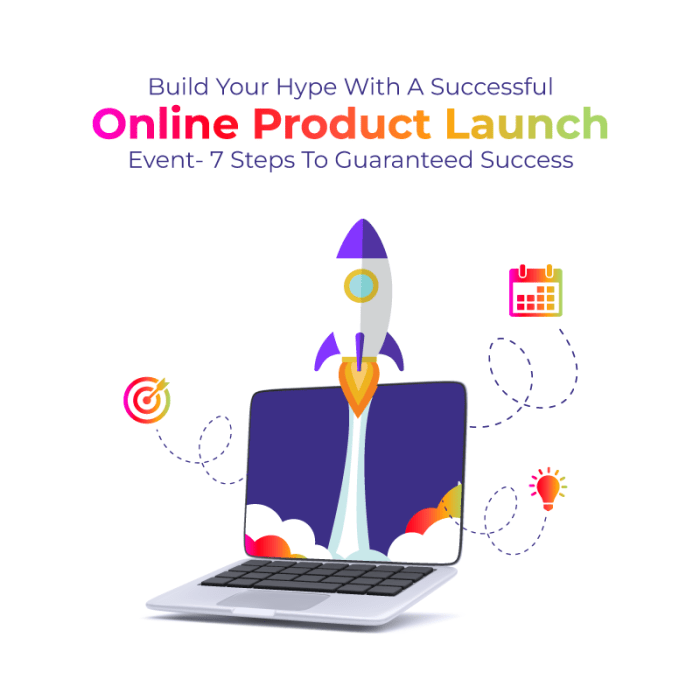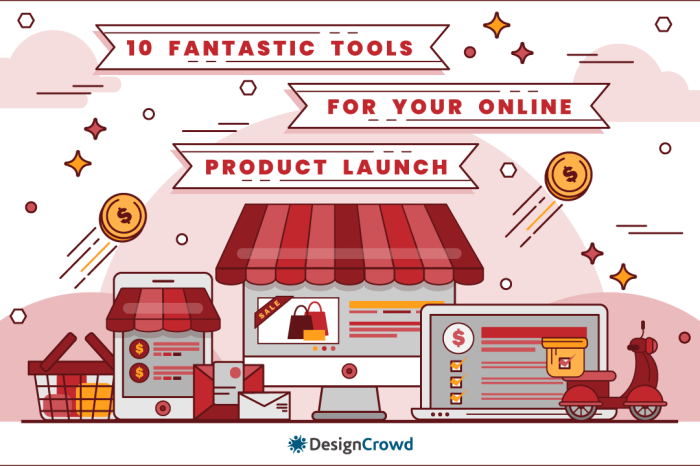Launching a Product Online: Mastering the Digital Marketplace opens the door to a world where innovation meets strategy, captivating readers with insights that pave the way for successful online product launches.
In today’s fast-paced digital landscape, understanding market trends, crafting engaging websites, leveraging social media, implementing strategies, and managing customer relationships are vital components of a successful product launch strategy.
Researching Market Trends: Launching A Product Online
Researching market trends before launching a product online is crucial for success in today’s fast-paced digital landscape. By understanding the current market dynamics, consumer behavior, and emerging trends, businesses can tailor their product offerings to meet the needs and preferences of their target audience.
Key Factors to Consider
- Consumer Demand: Analyzing what customers are looking for and how their preferences are evolving can help businesses create products that resonate with their target market.
- Competitor Analysis: Studying the strategies and offerings of competitors can provide valuable insights into market gaps and opportunities for differentiation.
- Technological Advancements: Keeping abreast of technological trends can help businesses leverage the latest tools and platforms to reach and engage with customers more effectively.
- Social Media and Online Behavior: Understanding how consumers interact with brands online and on social media can inform product positioning, marketing strategies, and communication channels.
Examples of Successful Product Launches
Apple AirPods: Apple’s launch of AirPods capitalized on the growing trend of wireless earbuds and the shift towards a wireless ecosystem, resulting in a highly successful product that dominated the market.
Instant Pot: The Instant Pot’s success can be attributed to its ability to tap into the trend of time-saving kitchen appliances and the growing interest in healthy cooking, resonating with busy consumers looking for convenient meal solutions.
Creating a Product Launch Strategy

To successfully launch a product online, it’s essential to have a well-thought-out strategy in place. This involves planning every step of the launch process, from pre-launch teasers to post-launch follow-ups.
Setting Specific Goals and Objectives
When creating a product launch strategy, setting specific goals and objectives is crucial for measuring success and staying on track. These goals should be SMART: Specific, Measurable, Achievable, Relevant, and Time-bound.
- Define your target audience: Identify who your product is for and tailor your launch strategy accordingly.
- Create a timeline: Establish a timeline with clear milestones leading up to the launch date.
- Utilize multiple marketing channels: Implement a multi-channel approach to reach a wider audience.
- Generate buzz: Build anticipation through teasers, sneak peeks, and behind-the-scenes content.
- Offer incentives: Provide early-bird discounts, exclusive access, or limited-time offers to encourage early adoption.
Examples of Effective Product Launch Strategies
Some well-known brands have mastered the art of product launches with innovative strategies that have captured consumer attention and driven sales.
Apple’s product launches are a prime example of building anticipation and creating hype around new releases. Their secretive approach, keynote events, and pre-order frenzy generate massive buzz.
Nike’s limited-edition drops and collaborations with celebrities and influencers have been incredibly successful in creating exclusivity and driving demand.
Tesla’s approach of unveiling new products through live events and interactive experiences has helped them create a loyal fan base and generate excitement around each launch.
Building an Engaging Website
Creating an engaging website for a product launch is crucial to capture the attention of potential customers and drive conversions. A well-designed website can make a lasting impression and encourage visitors to explore the product further. Here are the essential elements and tips to consider when building a website for a product launch:
Essential Elements for an Engaging Website
- Compelling Visuals: Use high-quality images and videos to showcase the product and create visual interest.
- Clear Call-to-Action: Make it easy for visitors to know what action to take next, whether it’s signing up for updates or making a purchase.
- User-Friendly Navigation: Ensure that the website is easy to navigate, with clear menus and links to relevant information.
- Engaging Copy: Use persuasive and informative content to highlight the benefits of the product and connect with the audience.
- Mobile Responsiveness: Optimize the website for mobile devices to reach a wider audience and provide a seamless browsing experience.
Design Aspects for Visitor Retention
- Eye-Catching Layout: Use a clean and visually appealing layout that guides visitors through the website smoothly.
- Interactive Elements: Incorporate interactive features like quizzes, polls, or product demos to engage visitors and keep them on the site longer.
- Consistent Branding: Maintain a consistent color scheme, typography, and branding elements throughout the website for a cohesive look.
- Social Proof: Display customer testimonials, reviews, or endorsements to build trust and credibility with potential customers.
Optimizing for Conversions
- Streamlined Checkout Process: Simplify the checkout process to reduce friction and increase the likelihood of completing a purchase.
- Optimized Landing Pages: Create dedicated landing pages for specific products or promotions to increase conversions and track performance.
- A/B Testing: Experiment with different design elements, copy, and calls-to-action to determine what resonates best with your audience and drives conversions.
- Analytics Tracking: Use tools like Google Analytics to monitor website traffic, user behavior, and conversion rates to make data-driven decisions for optimization.
Leveraging Social Media
Social media plays a crucial role in promoting and generating buzz for a product launch. With billions of users on various platforms, businesses can reach a wide audience quickly and effectively. Leveraging social media can help increase brand visibility, drive product awareness, and ultimately boost sales.
Key Social Media Platforms
- Instagram: Known for its visual content, Instagram is great for showcasing products through images and videos. Utilize features like Stories and Reels to engage with your audience in a more interactive way.
- Facebook: With a large user base, Facebook offers various advertising options to target specific demographics and interests. Create engaging posts, run targeted ads, and interact with customers through comments and messages.
- Twitter: Ideal for real-time updates and conversations, Twitter can help generate buzz around your product launch. Use hashtags to increase visibility and engage with influencers to reach a larger audience.
- LinkedIn: Particularly effective for B2B products, LinkedIn can help establish credibility and connect with industry professionals. Share informative content, participate in relevant groups, and utilize LinkedIn Ads for targeted promotion.
Creating Engaging Social Media Content
- Visuals are key: High-quality images and videos are more likely to capture the attention of users scrolling through their feeds. Invest in professional photography or graphic design to make your posts stand out.
- Consistent branding: Ensure that your social media profiles are cohesive in terms of branding, messaging, and tone. Consistency helps build brand recognition and trust among your audience.
- User-generated content: Encourage customers to share their experiences with your product through testimonials, reviews, or user-generated content. This not only boosts credibility but also creates a sense of community around your brand.
- Interactive elements: Polls, quizzes, live videos, and contests can increase engagement and keep your audience interested. Encourage participation and create a dialogue with your followers to build a loyal customer base.
Implementing Strategies
Implementing (Search Engine Optimization) strategies is crucial in the online product launch process as it helps improve the visibility of a product on search engine results pages. By optimizing product pages for search engines, you can drive organic traffic to your website and increase your chances of reaching potential customers.
Key Strategies
- Research: Conduct thorough research to identify relevant s that potential customers are searching for. Use these s strategically in your product descriptions, titles, and meta tags.
- On-Page Optimization: Optimize product pages by including relevant s in the URL, title tags, meta descriptions, and image alt text. Ensure that your content is high-quality, informative, and engaging.
- Link Building: Build backlinks from reputable websites to improve the credibility and authority of your product pages. Consider guest posting, influencer collaborations, and social media promotion to attract more traffic.
Optimizing Product Pages
- Meta Tags: Write compelling meta titles and descriptions that include relevant s to increase click-through rates from search engine results pages.
- Image Optimization: Optimize product images by using descriptive filenames and alt text to improve visibility in image search results.
- Mobile-Friendly Design: Ensure that your product pages are responsive and mobile-friendly to provide a seamless user experience across devices.
Managing Customer Relationships

Building strong customer relationships during a product launch is crucial for the success of the launch and the long-term success of the product. Engaging with customers helps to create brand loyalty, increase customer satisfaction, and gather valuable feedback for future improvements.
Effective Ways to Engage with Customers, Launching a Product Online
- Utilize social media platforms to interact with customers in real-time, respond to their comments and messages, and address any concerns they may have.
- Personalize communication by sending targeted emails, offering exclusive deals, and providing tailored recommendations based on customer preferences.
- Implement a customer support system that is easily accessible, responsive, and provides solutions to customer issues promptly.
Examples of Brands Excelling in Customer Relationship Management
Apple:
Apple has a dedicated customer support team that offers personalized assistance to customers, addressing their queries and providing technical support efficiently.
Amazon:
Amazon has a strong focus on customer satisfaction and has implemented features like easy returns, fast shipping, and personalized product recommendations to enhance the overall customer experience.
